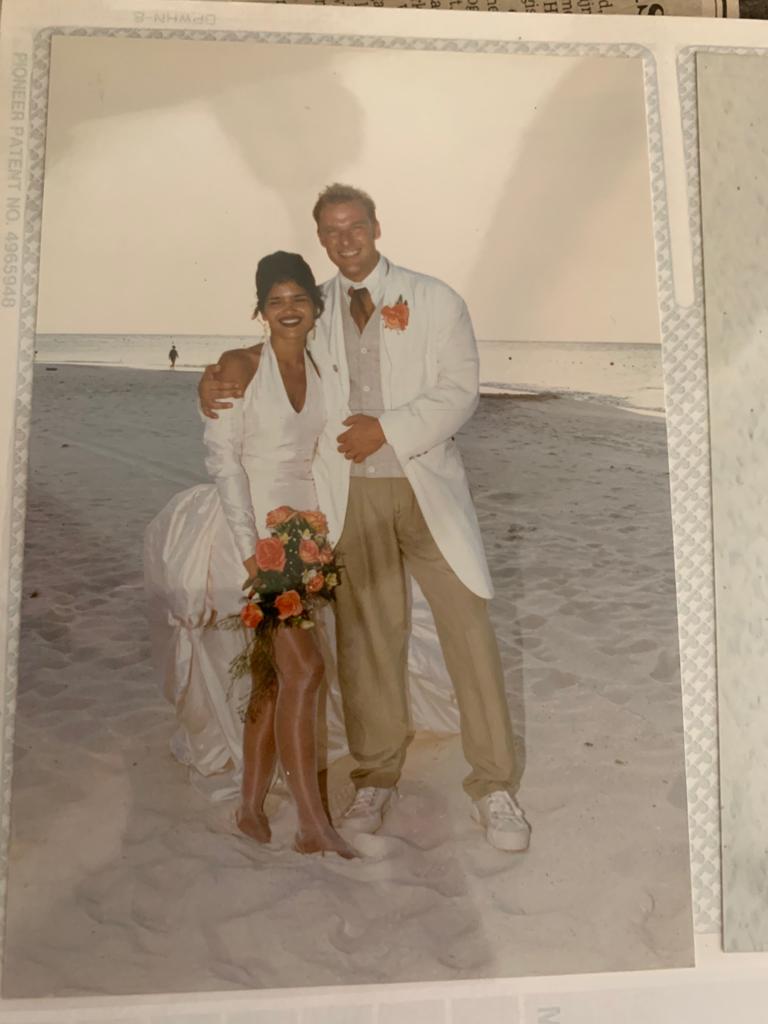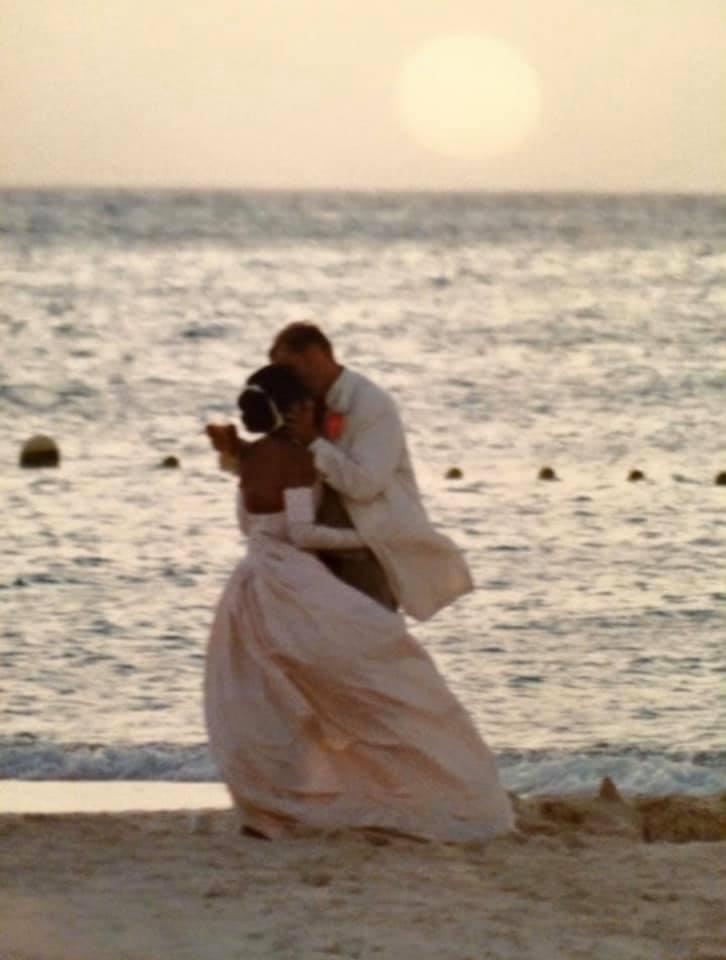My family history
(Amy's class)


When I think of something that symbolises my family history, I immediately go back to the wedding pictures of my parents. A short woman with dark black hair and squinted eyes hand in hand with a tall blonde man, both of them smiling. Aruba is where my parents met and where my mother is from. Even though she has a very mixed background with all sorts of cultures flowing through her, Aruba is the island she grew up on. My father on the other hand is not as mixed and as far as we know for the most part only has dutch blood in his veins. Even though I love both my family’s, we don’t have the tightest connection with our dutch family. And I only get to see my Aruban family once every few years. That’s why when I think of my family history, I think of my parents. They are who I look up to and who I ask when I got questions about our history. They both make me feel connected with both cultures and see the beauty in them. They are very loving and the story of how they met has always been very magical to me. That's why I decided to capture the moment they met up until they got married at sunset in a short audio experience. I asked them both to speak in their 'native' language so part of the audio is Dutch and part is Papiamentu.
Click on video to play
A memory
(Julie's class)
This place,
This sacred place, a place of love,
A place where she finally felt she had found her future
A place that meant so much
We had already known that the bridge had collapsed
But when we finally arrived, It was like my mother had expected to see it intact
Tears rolling down her cheeks had me confused
I didn’t think that this big rock had meant so much
But she and the bridge had a history together
They’d shared moments she held in the deepest of her heart
They were old friends, and it had hurt her to see her friend like this
So every time we go to this place, I think it hurts her a little bit but she won’t tell
But we are all there with her, the future she had found at this place
Decolonisation as care Uzma Rizvi
Teana's class
"A simple example might be to consider my own childhood: as a person of South Asian heritage, I was often confounded while dealing with crayons that did not have any color to represent my skin tone. I was told by teachers to color in bodies as ‘peach’ because that was the norm in the 1970s, in the United States. But my body was not peach.
The disjuncture, cognitive dissonance, and alienation between what I experienced as body and what I represented was unaccounted for: the tools (i.e. crayons) and the representation could not align unless I let go of wanting to see myself represented in that image. I had to make myself into something I was not, and it very quickly became clear to me that I was not the ‘norm’ in the world of crayons." p87

This is actually a problem that didn’t occur to me when I was younger myself. This is because I am a white person and so I would never really face situations where I didn’t feel represented. A few years back I went to the graduations projects of the WDKA before I was a student there. I remember seeing a project that was all about this subject. The artist talked about the bigger obvious ways in which racism lives in our society, like representation in tv shows and movies. But they also spoke about the more hidden things like crayons and bandaids. I remember at that moment I was so shocked, I couldn’t believe that I never really thought about these objects before. While I wrote the word ‘hidden’ two sentences before this one, I was reminded of something Gloria Wekker wrote in the introduction of white innocence. It was a part about the words autochtoon and allochtoon and how even though these words are not necessarily ugly/violent words, they are actually the most dangerous types of words in our language. Just like with the crayons and with these words, racism is ‘hiding in plain sight’. It is of great importance to be very alert of these things and to actively focus on them, and not just turn my back to them because they don’t disadvantage me.
"Often we feel trapped in one system, and we feel the system is so much larger than we are; but we are the ones who are keeping that system going. So once you recognize the inequity, and trace how your own body is being disciplined and kept in a certain place, you can begin to think through how you might design intervention, as a creator of cultural material. "p90
I often think about how the thought ‘But the world is so big, how will me doing this one thing, make any change?’ Is actually so bizarre. We’re probably all thinking this same thought, which means that if nobody had this thought as an obstacle, there would already be so much change in the world. Take eating plant based for example, I’ve already heard so many people say that them not eating meat won’t change anything. Imagine if everybody thinks that way.
Lately I’ve been thinking a lot about how exciting the times are for all the new artists now entering the art world. For example I study audiovisual design and I feel like us as filmmakers still have so much more to offer to the film world than what is already there. We live in a time where there is much more awareness about inequity and the lack of representation in film. With this knowledge I feel like we can make a real change. And so I want to get rid of this idea that me doing something won’t change the world, I need to do what I know is good.

"That realization is a small gesture that has huge implications for the ways in which the material culture of schools can be changed. A key tenet of decolonization has to also include a sense of intersectionality. So another clear example might be the heteronormativity of public bathroom spaces, particularly in schools. If the architecture of our early childhood spaces structurally reiterates gender binaries, we will never grow up to really be comfortable in non-gendered bathrooms because our comfort is first introduced and developed at a young age. Prior to those moments, most children do not think very much about who is around them when they perform any biological act. If we change the gender markings of early education bathrooms, we have changed the embedded social meaning of everyday practice in the future." p89

I agree with this a lot. About 2 years ago I followed the practice performing radical. In this class the teacher once opened a conversation about this bathroom subject. While talking about this we also discovered that there are actually a lot of occasions where the genders got divided. This also happened during self defense class for example. Every once in a while all the girls got taken to another classroom to talk about self defense. I once heard that the boys had gym class during this time. Making these clear choices in separating the girls from the boys teaches them a lot of bad things for later in life, because the kid years are very vital to learn information.
Just like Uzma Rizvi wrote, these things make it harder for people to be comfortable with terms like non-gendered bathrooms because they were never introduced to it before. I can also imagine that for a lot of people who struggle with figuring out their gender, it would have been very nice and reassuring to have been introduced to these types of topics when they were kids.
"If, due to your body experience, you have never had to question how the world looks at your race/class/ethnicity/ gender/body, or if that has never impacted the way the world identifies your research or work, you should know that that is a privileged experience. And that privilege or lack thereof, informs you and your praxis." p86

Like I wrote in my reaction to the crayon piece before, I have been in a very privileged position my whole life due to the reason that I am white. I never really struggled finding jobs or making new friends, which now more than when I was younger, I am very aware of. I study audiovisual design and even though my whiteness still gives me an advantage, there are some things that make me feel uncomfortable about the work field. During my studies I found out that the world of film is very male dominated. Not only almost all the big directors are male, but also almost every film production agency I ever applied to for internships or jobs are owned by men. Once I was showing my portfolio to two owners of a company during a portfolio night at school. I remember one of the things that they said to each other was that I might be nice to hire a girl for a change to make their workplace more diverse, which made me feel a little weird. It felt like if they would hire me, it maybe wouldn’t be because they really liked my work but to add a bit of spice to the company. I ended up not applying to the job.
Uzma Rizvi
My Reaction